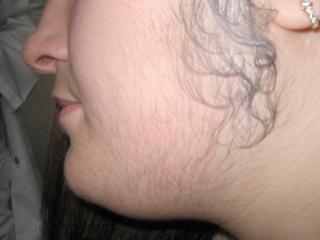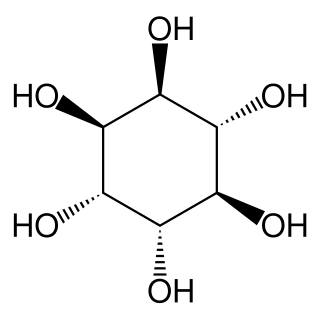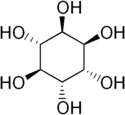
Polycystic ovary syndrome, or polycystic ovarian syndrome (PCOS), is the most common endocrine disorder in women of reproductive age. The syndrome is named after cysts which form on the ovaries of some women with this condition, though this is not a universal symptom, and not the underlying cause of the disorder.

Hirsutism is excessive body hair on parts of the body where hair is normally absent or minimal. The word is from early 17th century: from Latin hirsutus meaning "hairy". It usually refers to a male pattern of hair growth in a female that may be a sign of a more serious medical condition, especially if it develops well after puberty. Cultural stigma against hirsutism can cause much psychological distress and social difficulty. Discrimination based on facial hirsutism often leads to the avoidance of social situations and to symptoms of anxiety and depression.
Anovulation is when the ovaries do not release an oocyte during a menstrual cycle. Therefore, ovulation does not take place. However, a woman who does not ovulate at each menstrual cycle is not necessarily going through menopause. Chronic anovulation is a common cause of infertility.

In biochemistry, medicine, and related sciences, inositol generally refers to myo-inositol, the most important stereoisomer of the chemical compound cyclohexane-1,2,3,4,5,6-hexol. Its formula is C6H12O6; the molecule has a ring of six carbon atoms, each with an hydrogen atom and a hydroxyl group (–OH). In myo-inositol, two of the hydroxyls, neither adjacent not opposite, lie above the respective hydrogens relative to the mean plane of the ring.

Hyperandrogenism is a medical condition characterized by high levels of androgens. It is more common in women than men. Symptoms of hyperandrogenism may include acne, seborrhea, hair loss on the scalp, increased body or facial hair, and infrequent or absent menstruation. Complications may include high blood cholesterol and diabetes. It occurs in approximately 5% of women of reproductive age.
Fertility medications, also known as fertility drugs, are medications which enhance reproductive fertility. For women, fertility medication is used to stimulate follicle development of the ovary. There are very few fertility medication options available for men.

Hydroxysteroid 17-beta dehydrogenase 6 is an enzyme that in humans is encoded by the HSD17B6 gene.

Aromatase deficiency is a rare condition characterized by extremely low levels or complete absence of the enzyme aromatase activity in the body. It is an autosomal recessive disease resulting from various mutations of gene CYP19 (P450arom) which can lead to ambiguous genitalia and delayed puberty in females, continued linear growth into adulthood and osteoporosis in males and virilization in pregnant mothers. As of 2020, fewer than 15 cases have been identified in genetically male individuals and at least 30 cases in genetically female individuals.

The chemical compound 1L-chiro-inositol is one of the nine stereoisomers of cyclohexane-1,2,3,4,5,6-hexol, with formula C6H12O6, the generic "inositol". Its molecule has a ring of six carbon atoms, each bonded to a hydrogen atom and a hydroxyl group (–OH). Imagining the ring is horizontal, the hydroxyls on carbons 1, 2, and 4, in clockwise order are above the respective hydrogens, while the other three are below them.

In organic chemistry, a cyclitol is a cycloalkane containing at least three hydroxyl, each attached to a different ring carbon atom. The general formula for an unsubstituted cyclitol is C
nH
2n-x(OH)
x or C
nH
2nO
x where 3 ≤ x ≤ n.
Hyperthecosis, or ovarian hyperthecosis, is hyperplasia of the theca interna of the ovary. Hyperthecosis occurs when an area of luteinization occurs along with stromal hyperplasia. The luteinized cells produce androgens, which may lead to hirsutism and virilization in affected women.
Ovarian drilling, also known as multiperforation or laparoscopic ovarian diathermy, is a surgical technique of puncturing the membranes surrounding the ovary with a laser beam or a surgical needle using minimally invasive laparoscopic procedures. It differs from ovarian wedge resection, which involves the cutting of tissue. Minimally invasive ovarian drilling procedures have replaced wedge resections. Ovarian drilling is favored over wedge resection because cutting into the ovary might result in adhesions, potentially complicating postoperative outcomes. Ovarian drilling and ovarian wedge resection are treatment options to reduce the amount of androgen producing tissue in women with polycystic ovarian syndrome (PCOS). PCOS is the primary cause of anovulation, which results in female infertility. The induction of mono-ovulatory cycles can restore fertility.

Gynecomastia is the abnormal non-cancerous enlargement of one or both breasts in males due to the growth of breast tissue as a result of a hormone imbalance between estrogens and androgens. Gynecomastia can cause significant psychological distress or unease.
An estrogen-dependent condition can be that relating to the differentiation in the steroid sex hormone that is associated with the female reproductive system and sex characteristics. These conditions can fall under the umbrella of hypoestrogenism, hyperestrogenim, or any sensitivity to the presence of estrogen in the body.
Obesity is defined as an abnormal accumulation of body fat, usually 20% or more over an individual's ideal body weight. This is often described as a body mass index (BMI) over 30. However, BMI does not account for whether the excess weight is fat or muscle, and is not a measure of body composition. For most people, however, BMI is an indication used worldwide to estimate nutritional status. Obesity is usually the result of consuming more calories than the body needs and not expending that energy by doing exercise. There are genetic causes and hormonal disorders that cause people to gain significant amounts of weight but this is rare. People in the obese category are much more likely to suffer from fertility problems than people of normal healthy weight.

The HAIR-AN syndrome is a rare subtype of polycystic ovary syndrome (PCOS) characterized by hyperandrogenism (HA), insulin resistance (IR) and acanthosis nigricans (AN). The symptoms of the HAIR-AN syndrome are largely due to severe insulin resistance, which can be secondary to blocking antibodies against the insulin receptor or genetically absent/reduced insulin receptor number/function. Insulin resistance leads to hyperinsulinemia which, in turn, leads to an excess production of androgen hormones by the ovaries. High levels of androgen hormones (hyperandrogenism) in females causes excessive hair growth, acne and irregular menstruation. Patients with both underlying mechanisms of insulin resistance may have more severe hyperandrogenism. Insulin resistance is also associated with diabetes, heart disease and excessive darkening of the skin

Ethinylestradiol/cyproterone acetate (EE/CPA), also known as co-cyprindiol and sold under the brand names Diane and Diane-35 among others, is a combination of ethinylestradiol (EE), an estrogen, and cyproterone acetate (CPA), a progestin and antiandrogen, which is used as a birth control pill to prevent pregnancy in women. It is also used to treat androgen-dependent conditions in women such as acne, seborrhea, excessive facial/body hair growth, scalp hair loss, and high androgen levels associated with ovaries with cysts. The medication is taken by mouth once daily for 21 days, followed by a 7-day free interval.

Non-Steroidal Aromatase Inhibitors (NSAIs) are one of two categories of aromatase inhibitors (AIs). AIs are divided into two categories, steroidal aromatase inhibitors and non-steroidal aromatase inhibitors that is based on their mechanism of action and structure. NSAIs are mainly used to treat breast cancer in women. NSAIs binding is a reversible process where NSAIs binds to the aromatase enzyme through non-covalent interactions. When aromatase inhibitors (AIs) are used to treat breast cancer the main target is the aromatase enzyme which is responsible for the high estrogen level.
Female fertility agents are medications that improve female’s ability to conceive pregnancy. These agents are prescribed for infertile female who fails to conceive pregnancy after 1-year of regular and unprotected sexual intercourse. The following will cover the advancements of female fertility agents, major causes of female infertility. Next, it emphasizes on common female fertility agents in terms of their mechanism of action, side effects, fetal consideration and clinical application and ended up by the introduction of supplements and herbal medicines for female infertility.

Cyclohexane-1,2,3,4,5,6-hexol is a family of chemical compounds with formula C6H12O6, whose molecule consists of a ring of six carbon atoms, each bound to one hydrogen atom and one hydroxyl group (–OH). There are nine stereoisomers, that differ by the position of the hydroxyl groups relative to the mean plane of the ring. All these compounds are sometimes called inositol, although this name most often refers to a particular isomer, myo-inositol, which has many important physiological roles and medical uses.













